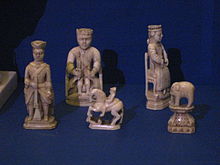Walrus ivory


polar bears attacking walrus, dating from the 1940s in Chukotka (Magadan
Regional Museum).Walrus ivory, also known as morse,[1] comes from two modified upper canines of a walrus. The tusks grow throughout life and may, in the Pacific walrus, attain a length of one metre.[2] Walrus teeth are commercially carved and traded; the average walrus tooth has a rounded, irregular peg shape and is approximately 5 cm in length.
The tip of a walrus tusk has a
dentine
. These cracks can be seen throughout the length of the tusk. Whole cross-sections of walrus tusks are generally oval with widely spaced indentations. The dentine is composed of two types: primary dentine and secondary (often called osteodentine). Primary dentine has a classical ivory appearance. Secondary dentine is marble or oatmeal-like.
Carving
Walrus-
collectives were established in villages in Chukotka, notably Uelen. International trade is, however, somewhat restricted by the Convention on the International Trade of Endangered Species (CITES)
.
Reliquary Cross
, 10th cIn the
elephant ivory reaching Europe reduced or ceased after the Muslim conquests, walrus ivory began to be traded by Vikings into northern Europe as a replacement. King Alfred the Great of Wessex records that he was presented with walrus tusks by the Viking trader Ohthere of Hålogaland in about 890, which may mark the start of this trade.[3] Nearly all ivories in Anglo-Saxon art use walrus, and most northern European ivories of the 11th and 12th centuries. Initially large walrus herds were found much further south than is the case today, and it is likely that their hunting for ivory greatly impacted on populations. Around 1160 northern European ivory carving was greatly reduced, which may well be because the material was less easily available. Around 1260, at the start of the Gothic period, elephant ivory began to reach Europe again, and the industry greatly increased.[4] The Norse also carved items in walrus ivory, notably the Lewis chessmen
.
See also
Notes
References
- ISBN 9780714128092
- Nasoori, A, (2020) Tusks, the extra-oral teeth, Archives of Oral Biology, https://doi.org/10.1016/j.archoralbio.2020.104835 PDF: https://drive.google.com/file/d/1ux2OWcKU67O-4v0vHeflljrh6lZkrekG/view?usp=sharing
- Williamson, Paul. An Introduction to Medieval Ivory Carvings, 1982, ISBN 0112903770
External links
Wikimedia Commons has media related to Walrus ivory.
Smithsonian Cooper-Hewitt, National Design Museum. "Pipe #1926-37-61". Smithsonian Cooper-Hewitt, National Design Museum. Retrieved 10 October 2012.
